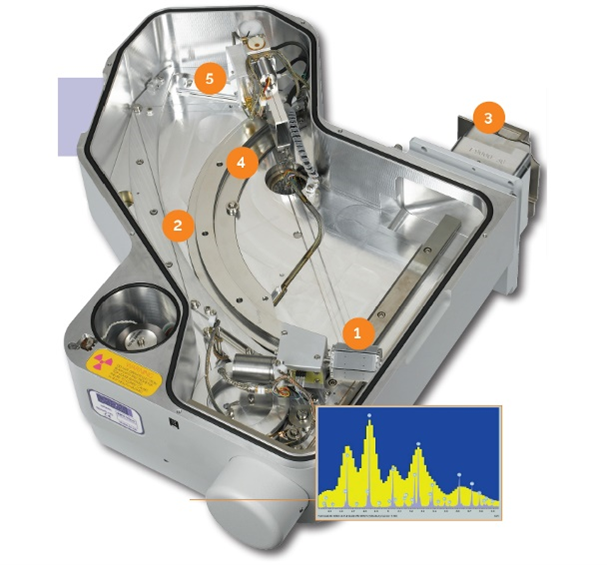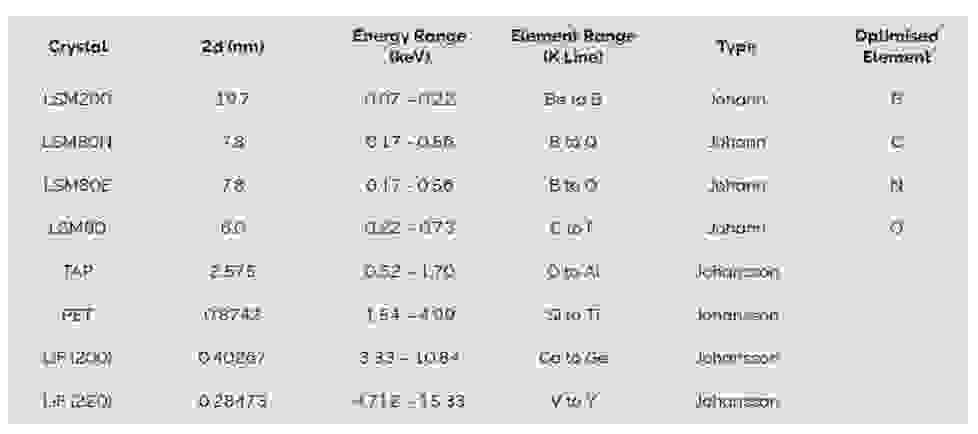Using Wavelength Dispersive X-ray Spectrometry (WDS), scientists can study the elemental distribution and composition of samples with a scanning electron microscope (SEM, FIB-SEM) or an electron microprobe (EPMA). The Oxford Instruments WDS spectrometer uses the AZtecWave software package, a materials characterisation software that facilitates research at the micro and nanoscale.
In the AZtecWave WDS Spectrometer, diffracting crystals are mounted on a six-position computer-controlled turret. The Wave spectrometer is available in two standard crystal configurations. The Wave 500 includes the following 4 crystals; LSM80N, TAP, PET and LiF (200), which gives it a quantification range of 0.17 – 10.84 keV allowing for the analysis of boron (B) through to plutonium (Pu). The Wave 700 includes the following 5 crystals; LSM200, LSM60, TAP, PET and LiF (200), which gives it a quantification range of 0.07 – 10.84 keV, allowing for the analysis of beryllium (Be) to plutonium (Pu).

Figure 1. Components of the Wave Spectrometer 1. Computer controlled rotating crystal turret 2. Rowland circle 3. Gate valve through which X-rays come from the sample 4. Entrance slit 5. Proportional counters
I recently had the opportunity to choose some of the crystals for our new Wave Spectrometer, soon to be mounted on a demonstration SEM at the Oxford Instruments office in the Paris region. In addition to the standard diffracting crystal configurations, other crystals can be added/exchanged, up to a total of six, depending on the analytical requirements. Many samples come through the Paris demo site; it can be necessary to analyse a Li battery one day, a rock sample the next day, and a heavy metal at the end of the week! I was given the chance to make some changes to the standard crystal configurations for our new Wave Spectrometer. The full list of crystals for Wave is presented in the table below.

Initially I opted for the LiF220, LSM60 and LSM200, in addition to the required TAP, PET, LiF200, as this would give the largest range of elements for analysis. I found it difficult to choose between the LSM crystals, which are optimised for particular light elements; LSM200 for boron, LSM80N for carbon, LSM80E for nitrogen and LSM60 for oxygen.
Ultimately, we ended up going with the LSM80N and LSM80E, instead of the LSM60 and LSM200, because during most of our demonstrations, users specifically request quantification of carbon and nitrogen - the two elements the two LSM80 crystals are optimised for. So, our new Wave spectrometer will include the following six crystals: TAP, PET, LIF200, LIF220, LSM80N and LSM80E.
WDS spectrometers are often found on scanning electron microscopes (SEM) and are a key part of an electron microprobe (EPMA). To find out more about WDS or to schedule a demonstration, contact an Oxford Instruments applications specialist.



